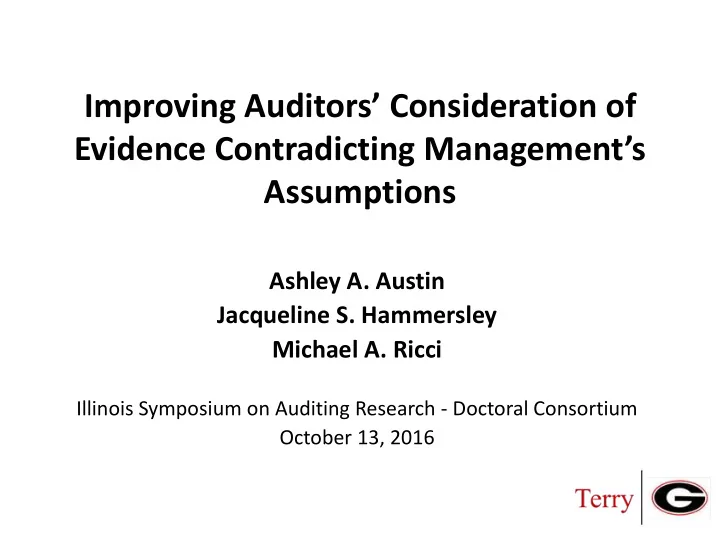

Improving Auditors’ Consideration of Evidence Contradicting Management’s Assumptions Ashley A. Austin Jacqueline S. Hammersley Michael A. Ricci Illinois Symposium on Auditing Research - Doctoral Consortium October 13, 2016
Motivation Auditors verify management’s estimate instead of critically evaluating its reasonableness (Griffith et al. 2015) Auditors underweight or ignore contradicting evidence contained in their documentation (PCAOB 2010, 2012, 2014) Auditors dismiss evidence contradicting management's assumptions
Research Question Can we reduce auditors’ dismissiveness of evidence contradicting management's assumptions by: 1) Focusing auditors on documenting evidence inconsistent with their preferred conclusion 2) Strengthening auditors’ goal of arriving at an accurate conclusion
Theory Focusing auditors on documenting evidence inconsistent with their preferred conclusion will disrupt dismissive processing Improved interpretation of evidence • More inferences that contradict management's assumptions • Strengthening auditors’ accuracy goals will make them less likely to initiate dismissive processing Auditors with weaker accuracy goals will benefit more from a focus • on documenting preference-inconsistent evidence
Hypotheses Dismissiveness of contradicting evidence Weaker Accuracy Goals Stronger Accuracy Goals Control Preference-Inconsistent Documentation Focus
Experiment Participants 114 senior auditors, average experience 48 months • Goodwill Impairment Task Evaluate revenue projections, which hinge on new product release • Listen to inquiries suggesting the new product may release late • Document inquiry evidence • Assess the reasonableness of the estimate • Describe issues to discuss with manager •
Independent Variables Documentation Focus Control vs. Preference-Inconsistent • Preference-inconsistent condition asked to document any issues • identified that are inconsistent with their conclusion about the projections Accuracy Goal Strength Weaker vs. Stronger • Stronger condition reminded to arrive at an accurate conclusion, • making sure the client’s numbers are as accurate as possible
Dependent Variables Dismissiveness of contradicting evidence Overall dismissiveness • Net inquiry inferences • Effectiveness of auditors’ evaluation of the biased estimate Reasonableness of the estimate • Relevant issues to discuss with manager •
Net Inquiry Inferences Documentation Focus: Preference- Accuracy Goal Strength: Control Inconsistent -0.55 -2.07 Weaker -1.31 A C -0.20 -1.80 Stronger -1.00 B D -0.37 -1.94 ANOVA Table: df F p-value Documentation Focus 1 9.83 0.002 Accuracy Goal Strength 1 0.39 0.535 Documentation Focus X Accuracy Goal Strength 1 0.01 0.939 Planned Contrasts: H1: Preference-Inconsistent < Control 9.83 0.001 H2: C – A < D – B 0.01 0.530
Structural Model Reasonableness Relevant Issues Overall Net Inquiry of the Fair to Discuss with Dismissiveness Inferences Value Manager + + - + Effectiveness of Dismissiveness Documentation Auditors’ of Contradicting Focus Evaluations of Evidence Link 1 Link 2 the Estimate -0.552 -0.241 p = 0.01 p < 0.01 Model Fit Statistics: Indirect Effect: χ 1 2 = 2.93, p = 0.69 99.5% of bias-corrected, CFI = 1.00 bootstrapped estimates RMSEA = 0.00 are > 0.014
Supplemental Analyses A preference-inconsistent documentation focus affects auditors’ • interpretation of available evidence, but not their choice about which facts to document Preference-inconsistent auditors do not just work harder • Auditors have strong accuracy goals, regardless of condition •
Conclusions A preference-inconsistent documentation focus: Interferes with motivated reasoning • Improves auditors’ interpretation available evidence • Improves audit quality in a difficult area • Strong accuracy goals do not preclude dismissive processing Documentation plays an important role in the formation of auditor judgments – it’s more than a mechanical exercise.
THANK YOU!
Recommend
More recommend